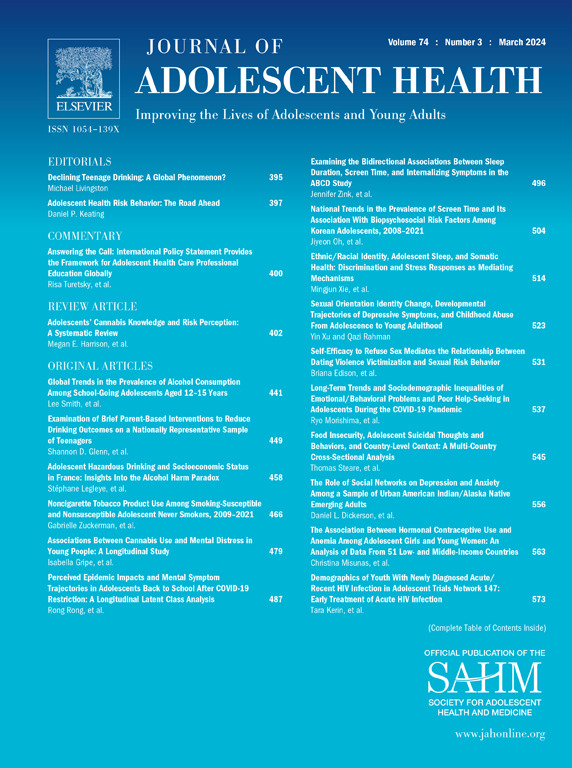2019冠状病毒病学校关闭期间对青少年福祉的多重影响:专业人士对未来政策的见解
IF 4.5
2区 医学
Q1 PEDIATRICS
引用次数: 0
摘要
目的:本研究探讨了2019冠状病毒病大流行期间学校关闭对全球卫生和教育专业人员根据联合国H6+框架报告的青少年福祉领域的影响。方法:在第二波COVID-19大流行期间(2021年3月至12月),以六种语言对自愿参加匿名在线调查的卫生和教育专业人员进行了半结构化的个人在线访谈。联合国青少年福祉的H6+ 5领域概念框架被用作对联合访谈数据集进行定向内容分析的框架。结果:共分析了来自28个国家/地区的38名教育专业人员和22名卫生专业人员的60次访谈(翻译成英语)。参与者报告显示了对所有五个青少年福祉领域的影响,但主要是领域1(良好的健康和营养)、领域3(安全和支持性环境)和领域4(学习、能力、教育、技能和就业能力)。2连通性和5代理的反映也存在。他们的报告主要包括负面影响,但也有一些积极的见解。讨论:政策制定者必须认识到大流行期间学校关闭对青少年福祉的多个领域的影响以及扩大不平等的可能性。学校起着重要的缓解作用,这超出了教育的范畴。青少年卫生界的行动呼吁是承认和处理日常实践中对福祉和不平等的持续潜在长期影响。同样重要的是,要在地方、国家和全球倡导认真考虑在未来的卫生危机中关闭学校的后果。本文章由计算机程序翻译,如有差异,请以英文原文为准。
Multiple Impacts on Adolescent Well-Being During COVID-19 School Closures: Insights From Professionals for Future Policy Using a Conceptual Framework
Purpose
This study explores the impacts of school closures during the COVID-19 pandemic on the domains of adolescent well-being from the UN H6+ framework, reported by health and educational professionals worldwide.
Methods
Semistructured individual online interviews were conducted in six languages during the second wave of the COVID-19 pandemic (March–December 2021) with health and education professionals who volunteered for follow-up after participating in an anonymous online survey. The UN H6+ 5-domain conceptual framework of adolescent well-being was used as a framework for the directed content analysis of the combined interview dataset.
Results
A total of 60 interviews—translated into English—were analyzed from 38 education and 22 health professionals in 28 countries/territories. Participant reports showed impacts on all five adolescent well-being domains, but mainly domain 1 (good health and nutrition), domain 3 (safety and a supportive environment) and domain 4 (learning, competence, education, skills, and employability). Reflections of 2-connectedness and 5-agency were also present. Their reports included mainly negative impacts, but also some positive insights to take forward.
Discussion
Policymakers must recognize impacts of school closures during the pandemic on multiple domains of adolescent well-being and the potential for widening inequalities. Schools play a critical mitigating role that goes beyond education. The call to action for the adolescent health community is to recognize and address ongoing potential long-term impacts on well-being and inequalities in their everyday practice. It is also important to advocate locally, nationally, and globally for careful consideration of the consequences of school closures in future health crises.
求助全文
通过发布文献求助,成功后即可免费获取论文全文。
去求助
来源期刊

Journal of Adolescent Health
医学-公共卫生、环境卫生与职业卫生
CiteScore
10.40
自引率
3.90%
发文量
526
审稿时长
46 days
期刊介绍:
The Journal of Adolescent Health is a scientific publication dedicated to enhancing the health and well-being of adolescents and young adults. Our Journal covers a broad range of research topics, spanning from the basic biological and behavioral sciences to public health and policy. We welcome a variety of contributions, including original research papers, concise reports, literature reviews, clinical case reports, opinion pieces, and letters to the editor. We encourage professionals from diverse disciplines such as Anthropology, Education, Ethics, Global Health, Health Services Research, Law, Medicine, Mental and Behavioral Health, Nursing, Nutrition, Psychology, Public Health and Policy, Social Work, Sociology, and Youth Development to share their expertise and contribute to our mission of promoting adolescent health. Moreover, we value the voices of young individuals, family and community members, and healthcare professionals, and encourage them to submit poetry, personal narratives, images, and other creative works that provide unique insights into the experiences of adolescents and young adults. By combining scientific peer-reviewed research with creative expressions, our Journal aims to create a comprehensive understanding of the challenges and opportunities in adolescent and young adult health.
 求助内容:
求助内容: 应助结果提醒方式:
应助结果提醒方式:


